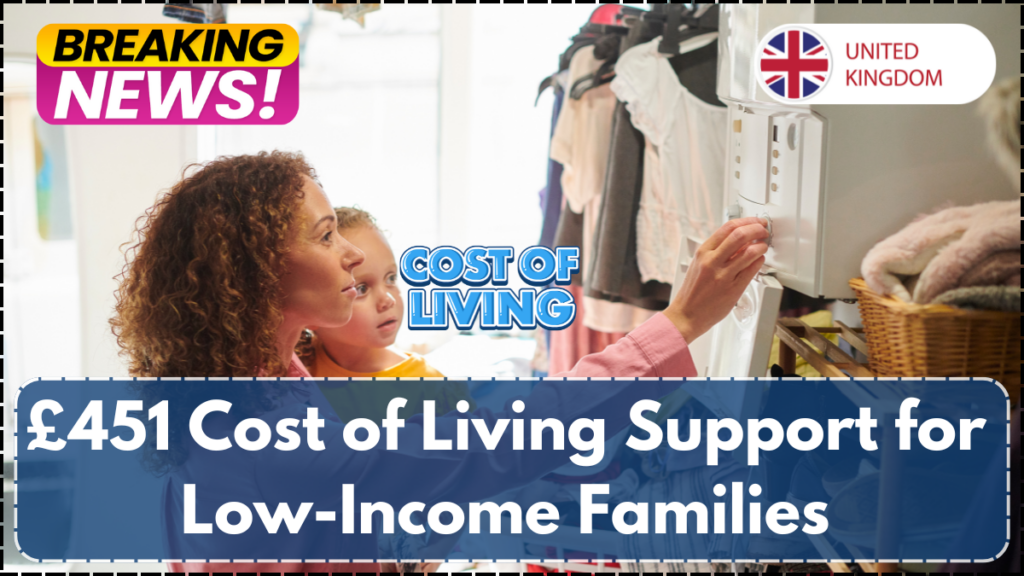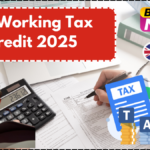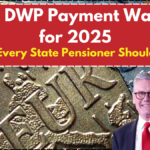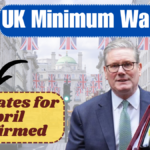To counter the growing pressure of inflation and financial instability, the UK Government has introduced a £451 Cost of Living Payment targeted at low-income families. This initiative is part of a broader strategy to help vulnerable individuals maintain financial security as everyday expenses continue to rise across the country.
Applicants must submit accurate personal and banking details to ensure timely disbursement. This initiative is particularly vital in April 2025, as the cost of essentials remains high and economic recovery remains uneven across sectors.

Understanding the Cost of Living in the UK (April 2025 Snapshot)
In April 2025, the cost of living in the UK remains one of the primary concerns for households—especially for those earning below the national average. Rising costs in groceries, rent, and utilities have placed considerable stress on families, making government support more essential than ever.
Average Monthly Expenses in the UK (2025)
| Category | Estimated Cost (Couple) | Estimated Cost (Single) |
|---|---|---|
| Food & Groceries | £500 | £250 |
| Utility Bills | £200 | £120 |
| Transportation | £180 | £100 |
| Council Tax & Other Fees | £200 | £130 |
| Personal Expenses | £300 | £150 |
| Total (Excl. Rent) | £1,380 | £750 |
| Average Rent (London) | £1,755 | £1,200 |
This brings the total monthly cost to approximately £3,135 for couples and around £1,950 for individuals in major UK cities. Despite slight variations in rural or suburban areas, affordability remains a national challenge.
Who Qualifies for the £451 Living Allowance?
To ensure fair distribution, the UK Government has set out clear eligibility criteria for the April 2025 round of the £451 payment:
-
Residency Status: You must be a legal resident of the UK with proof of address.
-
Age Requirement: Applicants must be at least 18 years old.
-
Income Threshold: Annual income must be £70,000 or less.
-
Tax Compliance: You should have filed a tax return for the 2021–22 financial year.
-
Criminal Background Check: Individuals must have no criminal record under review.
-
Income Level: This support covers those with low or zero income, including self-employed individuals and unemployed residents.
Providing verifiable details is crucial. Mismatched or incomplete information could result in delays or denial of the payment.
Purpose of the Allowance: Why This Payment Exists
This allowance is designed to ease the economic burden for families that are struggling to cover basic necessities. The government’s goal is to reduce the poverty rate, which continues to affect millions, and support those in or near financial crisis.
The payment is not just a financial handout—it’s a step toward stabilizing the economy. When citizens can afford housing, education, and food, the nation benefits as a whole. Recipients include people in debt, those with limited job opportunities, and individuals recovering from financial setbacks.
Latest Developments in Cost of Living: 2025 Trends
As of April 2025, inflation in the UK is hovering around 5.2%. While this marks a slight decrease from late 2023’s 6%, it still places a considerable strain on low- to middle-income households.
Students and young professionals are among the hardest hit, particularly those studying or living away from home. Alongside the £451 support, the government continues to offer other welfare benefits such as:
-
Universal Credit
-
Child Tax Credit
-
Working Tax Credit
-
Pension Credit
-
Housing Benefits
These schemes collectively aim to provide a safety net for residents dealing with rent increases, job instability, and rising educational costs.
Poverty in the UK: The Bigger Picture
As of 2025, over 12 million people in the UK are estimated to be living in poverty. This includes working families, full-time students, and elderly citizens relying solely on pensions.
Two of the most pressing causes of poverty remain:
-
Soaring Housing Costs – Rent prices continue to rise faster than wages.
-
Tax Burden on Low Earners – A significant portion of income is consumed by basic taxes and mandatory expenses.
While many of these individuals are employed, their income simply doesn’t align with the rising cost of living. The £451 payment serves as a buffer—offering temporary relief and giving households the breathing room to manage other critical expenses.
Conclusion
The £451 Cost of Living Allowance in April 2025 is more than just a one-time payment—it’s a crucial part of the UK’s response to widening income inequality and financial instability. If you meet the eligibility requirements, applying promptly and providing accurate details can secure essential financial support during a time when every pound counts.
Government assistance programs are evolving, and staying informed ensures you won’t miss out on valuable resources that could help your household stay afloat.
FAQs About the £451 Cost of Living Payment
What is the purpose of the £451 payment?
The payment is meant to assist low-income families and individuals in coping with rising living costs in the UK.
How can I apply for the payment?
You can apply through the UK Government’s official benefits portal. Make sure your information, especially your bank details and tax history, is up to date.
When will the payment be made?
Eligible residents can expect the payment to be disbursed in mid-to-late April 2025, depending on application processing times.
Is the payment taxable?
No, the £451 Cost of Living Payment is a non-taxable government benefit.
Can students apply?
Yes, if they meet the income and residency criteria, students may also qualify for the payment.
For More Information Click Here
Pari is a passionate writer known for captivating stories that blend imagination and reality. Inspired by travel, history, and everyday moments, Pari crafts narratives that resonate deeply with readers.




